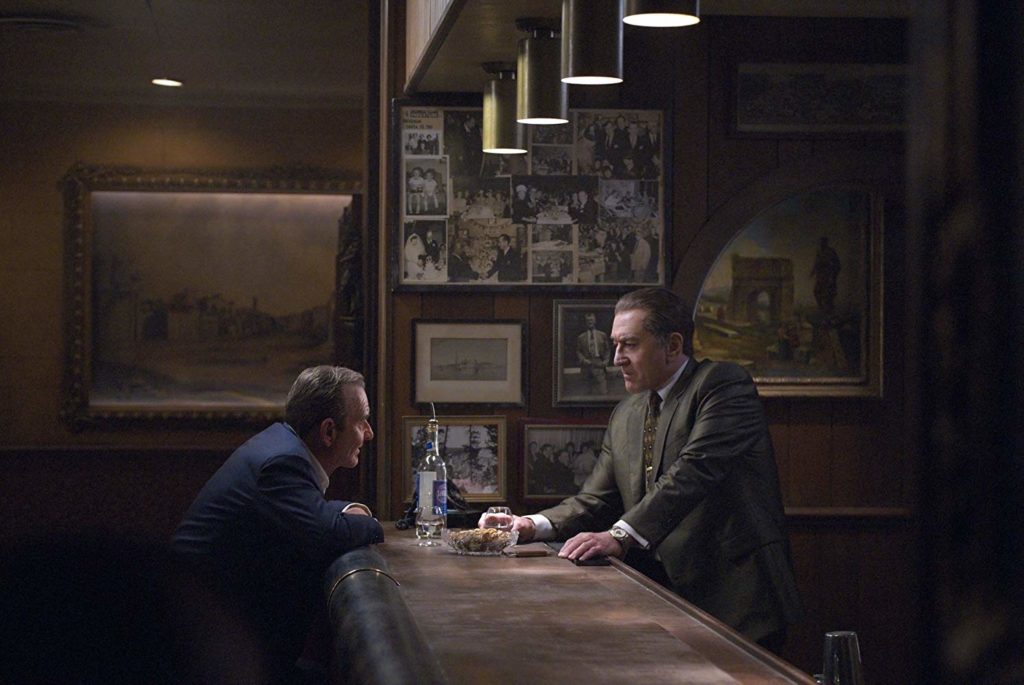Scorsese, De Niro, Pacino… I Heard You Paint Movie Houses.
DIRECTED BY MARTIN SCORSESE/2019
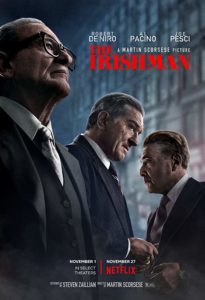
Even longer in the making than it is in its running, Martin Scorsese‘s three and a half hour-long intimate epic The Irishman stands tall as a masterful achievement of personal career reflection and expanse.
With no DiCaprio in sight, Scorsese wisely goes back to his previous enclave of regulars: Robert De Niro (playing true-life workaday gangster Frank “The Irishman” Sheeran), Joe Pesci (welcomed out of retirement to play mob bigwig Russell Bufalino), Harvey Kietel (In a small but memorable role) and making his long awaited debut with the director, Al Pacino (right at home as a particularly charismatic Jimmy Hoffa). To be sure, this is Martin Scorsese (often referenced as America’s greatest living director, a painter of the conflicted soul of the country) in his far-too-neglected comfort zone of mid-century organized crime. And it’s just where we like him.
Though things begin in a tenor reminiscent of the beginning of Goodfellas, The Irishman’s own narrative energy does not mirror that film, or even that of subsequent Scorsese crime films Casino or The Departed. Rather, it hits a certain groove and remains there. If anything, the no-longer-young Scorsese, working from a screenplay by Steve Zaillian that is based upon a book by Charles Brandt (more on that later), allows things to downshift into a fatalistic key as our main character ages his way into a nursing home, and inevitable isolation. The entire story is told in flashback from the comfort of his wheelchair. When one considers that the film on the whole comprises more than half of his long life, three and a half hours doesn’t seem so long after all.
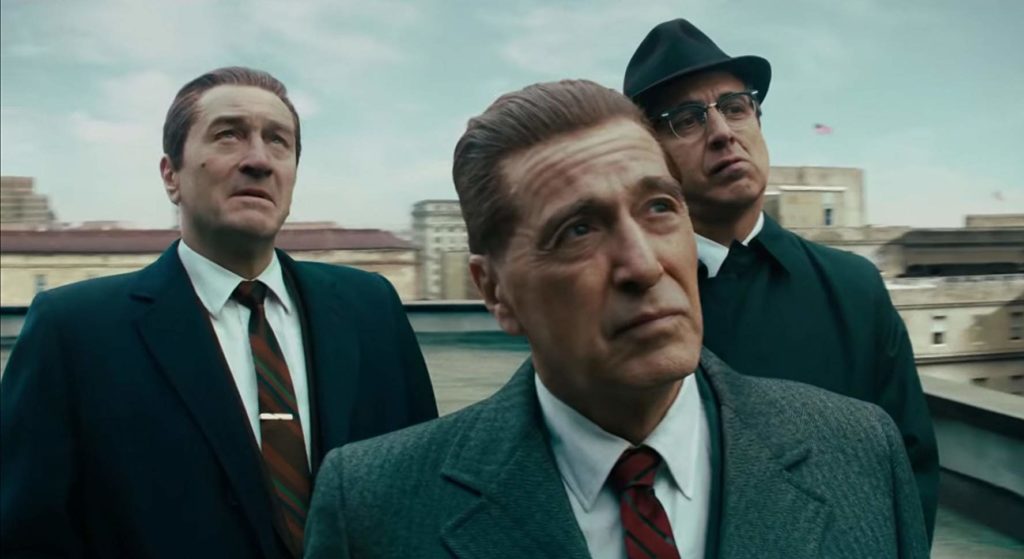
Nevertheless, watching this film in the distraction-filled comfort of home is a considerably less ideal way of experiencing it. Scorsese deals in cinema, pure and simple. He always has. With the fact that Netflix has enabled the existence of this long-brewing dream project comes the soul-selling truth that it is essentially a made-for-TV movie.
But the good news is, it’s not. Not really. At least, not now. For an all too brief window of time, The Irishman can be seen in select theaters. The relationship between theater chains and Netflix is almost always hostile to say the least, resulting in far fewer big screen options for this film than it deserves. (Wanna see The Irishman in style and in public? Let your local movie house know).
Those looking for a specific kind of Scorsese “return to form” are bound to be disappointed, as there’s no rock n’ roll, meaning no Rolling Stones needle-drops, or the like. The Irishman is a far less verbose and less violent endeavor than any of his past crime films. But like those films, it’s all about the internal culture of organized crime; in this case how it can so invisibly bleed into the largest avenues of legitimate, ordinary life. (The Teamsters, teaming with gangsters up top, were nothing short of America’s transportation system for practically any and all goods).
Within the relationships of the men in question (and in this era, it was always men in question), discourse was always a matter of what was said “between the lines”, as opposed to the surface banter. For anything really important, what’s left unspoken is the thing that speaks greatest volumes. In the life of Frank Sheeran, the brutal violence he carries out in advocating for his young children created an unspoken, lifelong irreparable divide with them. (Anna Paquin plays one of Frank’s grown daughters). Is “what matters most” truly what matters to us?
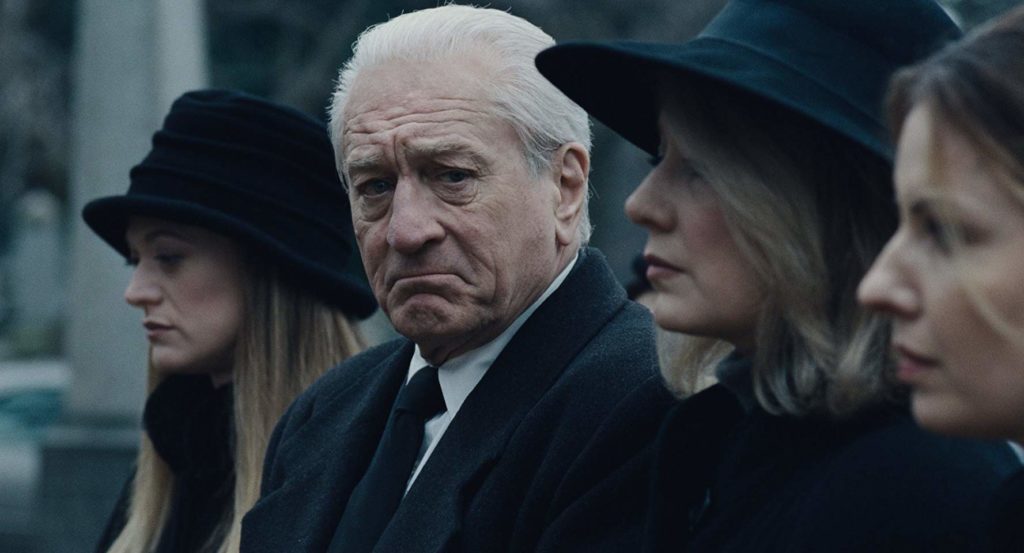
As a history lesson, The Irishman is no more reliable than Quentin Tarantino’s not-quite-as-long-winded Once Upon a Time in Hollywood. Adapted from the popular 2004 book I Heard You Paint Houses: Frank “The Irishman” Sheeran and Closing the Case on Jimmy Hoffa by Charles Brandt, Scorsese takes and runs with the author’s liberties. Though Brandt comes from a background of homicide prosecution, defense, and investigation, and includes seventy-one pages of expository backmatter in his book, it is a work of speculative fiction. The case of whatever happened to famed Teamsters president Jimmy Hoffa hasn’t, in actuality, been closed. (And it likely never will be).
Via this controversial source material, Scorsese eventually depicts a resolution. Per the film’s own earlier argument, “no one today knows what a big deal Jimmy Hoffa was”, The Irishman is therefore all the more likely to lead the uneducated astray. Is this socially responsible? No less so than Tarantino’s film, in which he deliberately works against known and proven history. This movie, stealthily easing from historical fiction into pure fiction, unknown and impossible to prove, could be viewed as all the more reckless. If you’ve come to the movie in search of a history lesson, you’ve come to the wrong place.
Also, don’t expect accuracy in terms of the ages and physicality of the lead actors in The Irishman. To truly sell the characters natural traversing of decades, Scorsese employed that digital de-aging technique that’s become all the rage in recent years. (This is the very de-aging that’s been put to use most prominently in assorted mid-decade Marvel movies before the studio went all in with it for Samuel L. Jackson’s character in Captain Marvel earlier this year. If Scorsese has actually seen any Marvel films, it was likely these, for this reason). The result, most prominently, is the return of a middle-aged De Niro, who’s Sheeran also eventually surpasses the actor’s current age.
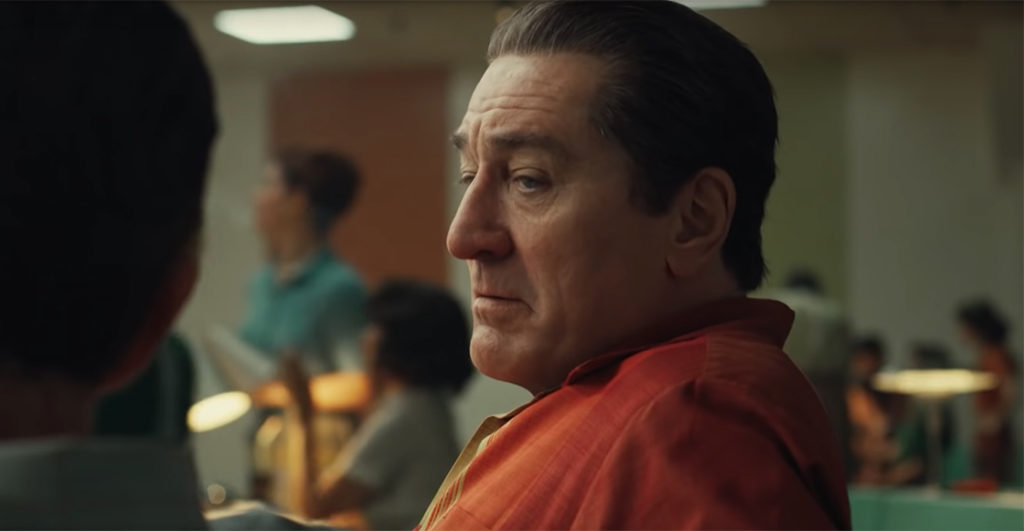
Though word is that the wait on the high volume of these digital effects stalled the release of The Irishman, prompting some to ask why Scorsese didn’t opt for more traditional means such as makeup or casting younger actors for certain scenes, there’s no disconnect that occurs in seeing De Niro tool about with a CGI facelift. The disconnect, albeit fairly minor, actually occurs in the telling physicality of seeing a man in his seventies trying to move about in the way a man in forties does. It’s simply not the same thing, as even actors as great as De Niro and Pacino (and both are quite great in this film) are unable to altogether suppress the effects of their own real-life aging.
Every shot of The Irishman is designed and photographed with a most pure, palpable passion.Scorsese’s own lifelong fascinations with and reconciliation of illicit life intermingling with spiritual life is something that eventually becomes apparent here. The exploration is both merely touched upon and a central crux- yet another dichotomy in a career obsessed with dichotomies.
Scorsese, like his characters, has attained the success he has attained by, in a sense, having things both ways: he makes “socially irresponsible” films about liars and killers while granting them humanity and telling the truth about them. Their declines are (mostly) inevitable, if not always the lead-laden machine-gunning final-act justice of classic Hollywood. (See: Cagney machine gunned on the steps in the final moments of The Twentieth Century. Or, Cagney’s corpse delivered to his family’s door in The Public Enemy. Or, Cagney finally “confess” just before his death by capital punishment at the end of Angels with Dirty Faces. These are the movies of this genre that Scorsese watched growing up- and still watches).
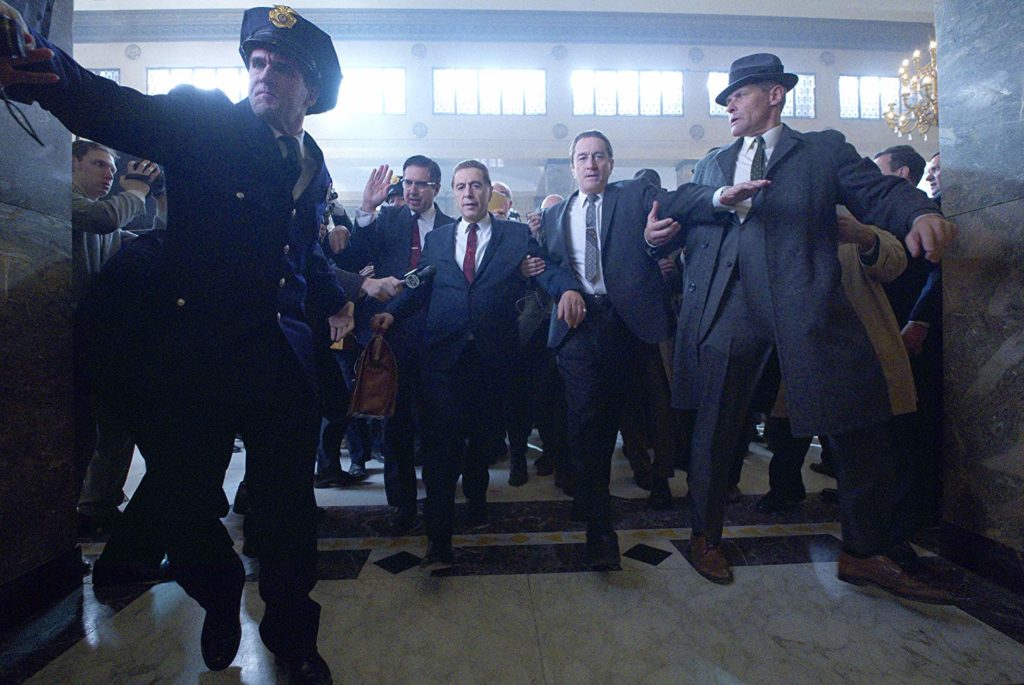
One question that The Irishman raises is this: In this quickly shifting not-so-brave new world of media consumption, is the fact that this most precious of large-scale directorial dream projects is relegated primarily to in-home television consumption the devil finally getting his due? And if so, was the pact worth it? For Scorsese, who’s seemingly long ago traded conventional worship for the Church of Cinema, the answer will always be the dangerous one.
The Irishman, meanwhile, is, out of the wet gate, top tier, essential Scorsese. Though seeing it theatrically may simply be too big of a logistical ask for many, that is undeniably the way to experience it. If not that, then a very controlled Netflix viewing will suffice. In any case, this movie, in all its justified yet indulgent decompression, lays bare and begins to untangle the murky moral tendrils of crime in American history. In that, we see and feel the personal ramifications of a successful career life poorly lived. Hollowness and loss of what matters most, then, is the cost of the disease of ego and the quest for status. By that rational, the humble profession of painting houses isn’t such a shameful thing… depending on who the painter is.
